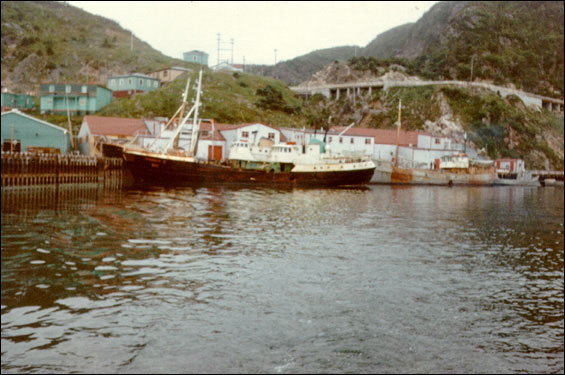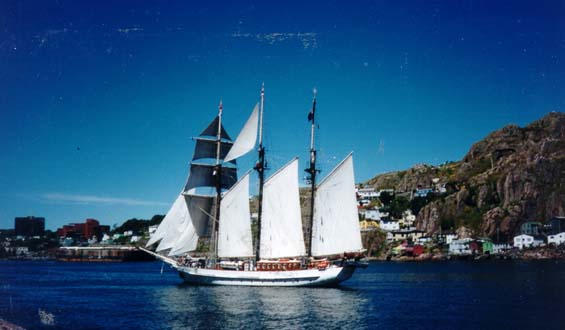20th Century Salt Fish Markets, 1914-1992
At the outbreak of war in 1914, the Newfoundland fishery was already in trouble. Population growth and declining catches had forced fishermen to adopt new technology, notably the cod trap, which helped increase catches but masked the growing ecological problem. Previous marketing trends continued in the years after the war, as exporters were forced to find new markets to compensate for those lost because of the declining quality of Newfoundland salt fish. Poor quality had lost Newfoundland market share in Europe and the Mediterranean to countries such as Norway and France, which had more stringent quality control regulations and centralized distribution systems. By 1914, Newfoundland's traditional European markets had been largely replaced by less-profitable Caribbean and Southern American markets.
Two world wars, the increasing popularity of frozen over salt fish, the development of marketing organizations, and Confederation all contributed to the changing nature of the fishery in the 20th century. By the time the ecological crisis came to a head in 1992, resulting in the cod moratorium, salt fish had been largely replaced by the frozen product.
First World War (1914-1920)
The First World War caused food prices to rise, which made the fishery more profitable. However, the war also increased costs, especially in shipping and insurance. There were shortages in shipping tonnage to export fish, aggravated by the fact that some merchants, taking advantage of high wartime prices, sold their steamers, further reducing the tonnage available to ship fish and drawing accusations of profiteering in the process. As fishermen joined the armed forces, manpower also became a problem. Nonetheless, wartime conditions kept prices high, and Newfoundland merchants continued to supply their traditional markets in Europe, the Mediterranean, Brazil and the Caribbean. The boom lasted until 1920.
Interwar Years (1920-1939)
From 1920 to 1939, Newfoundland once again struggled to compete in the international marketplace. Economically devastated by the war, many European countries were unable to import salt fish on the same scale as previously, and many imposed protective economic policies. In addition, the quality problem persisted, largely because wartime demand had further weakened the incentive to make high quality fish.
Europe remained Newfoundland's most important market in the early 1920s. Spain and Portugal took almost 50 percent of Newfoundland's salt fish exports, and Italy and Greece accounted for another 16.8 percent. By comparison, Brazil took 11.2 percent and the Caribbean 12.5 percent. However, old trends soon reasserted themselves. Exports to European and Mediterranean countries began to drop, and sales to Brazil and the Caribbean increased. Between 1935 and 1939, Spain and Portugal took just under 22 percent of Newfoundland salt fish exports, and Italy and Greece about 14 per cent. Brazil now accounted for almost 20 percent of Newfoundland salt fish exports, and as much as 40 percent went to the Caribbean, with Jamaica, Barbados and Puerto Rico being the largest consumers. In the 1930s Newfoundland also exported small amounts of wet-salted fish (as opposed to hard-dried salt fish, the traditional export product) or “saltbulk” to various markets, mainly the U.K., the U.S. and Canada. This trade amounted to a mere 2,000 - 5,000 tons annually.
Although Newfoundland was still a world leader in salt fish, overall production was steadily dropping throughout this period, from an average of 70,000 metric tons (approximately 1,378,000 quintals) in the 1920s to about 54,000 (approximately 1,063,000 quintals) in the 1930s. This was due partly to the ecological strain on cod stocks, but the Depression was largely responsible for later reductions as capital became scarce and demand dropped.
On behalf of the Department of Marine and Fisheries, D. J. Davies and Capt. Augustus Oldford visited Newfoundland's primary European salt fish markets in 1933, including Oporto, Lisbon, Alicante, Barcelona, Genoa, Naples, Patras, and Athens. Everywhere they found that imports of Newfoundland fish had either dramatically declined or had ceased altogether. The historically important market of Oporto, for example, imported only 169,000 quintals of Newfoundland fish that year, compared to 371,000 just five years before. The main reason in each case was the poor quality of Newfoundland fish, which gave a great competitive advantage to Norway, Iceland, and Greenland, which were now supplying most of the salt fish demanded by European and Mediterranean markets.
Second World War and Aftermath (1939-1947)
The Second World War partially and temporarily changed the situation for the better. Between 1940 and 1944, exports to Spain and Portugal increased sharply, to 15.1 and 29.5 percent respectively, largely because the war disrupted exports from Norway and Iceland. Italy and Greece were no longer accessible to Allied countries and took less than five percent between them. Brazil also dropped dramatically from almost 20 percent in the years immediately before the war to only seven percent in 1940-44. The Caribbean continued to be vitally important, accounting for 40 percent of Newfoundland exports. In 1943, the Combined Food Board was established by the Allies to control food supplies to the allied nations. It controlled exports of Newfoundland salt fish through marketing groups until 1946, thus ensuring steady markets and high prices. Similarly, the United Nations Relief and Rehabilitation Administration, established in 1943 to assist the recovery of war-torn countries, purchased large stocks of Newfoundland salt fish from 1944 to 1947, but this outlet was short lived.
Although prices and demand increased during the war, total production of Newfoundland salt fish did not, averaging just 42,000 metric tons annually between 1940 and 1944. Production increased to about 49,000 tons in the late 1940s, but the overall trend was downward.
1947-1969
In 1947, Newfoundland Associated Fish Exporters Limited (NAFEL) was established, and initially had some success in stabilizing and regaining markets. In 1950, Newfoundland exported 938,000 quintals of salt fish. Forty-five percent went to southern Europe, 31 percent to various Caribbean islands and Puerto Rico, seven percent to the U.S. and Canadian Mainland, four percent to Brazil, and about four percent to various other markets. But a 1951 marketing report was cautious about the future of the salt fish industry, noting that “only during wartime has there been a seller's market and relative prosperity to fishermen.”
Home freezers became common after the war, especially in the U.S., and demand for frozen instead of salt fish increased accordingly. This was an important development for the Newfoundland fishery: from the late 1940s salt fish was fighting a losing battle against market preferences for frozen or fresh fish. Frozen cod production increased from 13,000,000 pounds in 1943 to 39,000,000 in 1959, overwhelmingly for North American markets. Over the same period salt fish production stayed relatively stable at about 90,000,000 pounds. While salting was still popular in the 1950s, frozen fish soon came to dominate the industry.

Newfoundland found it difficult to compete in many markets in the 1960s. Quality problems persisted, and devaluations in international currencies made it hard for Newfoundland merchants to sell profitably. For example, Italy imported 48,200 metric tons of salt fish in 1961, but only five percent came from Newfoundland. Although the Portuguese, Spanish, Greek and Italian markets continued to import small amounts of Newfoundland salt fish, they were essentially lost. Many of these countries were developing their own fishing industries, and because Newfoundland was no longer producing high quality salt fish, Iceland, Denmark (through Greenland), and Norway had cornered these markets. Brazil, once responsible for about 30 percent of Newfoundland's exports, only imported about one percent of its salt fish from Newfoundland in 1961. The Caribbean continued to be important, especially Puerto Rico and Jamaica, although they too were in decline. Demand for fresh-frozen over salt fish was rising sharply in the 1960s, and producers were responding accordingly. In 1956, fully 70 percent of Newfoundland's codfish catch was salted. By 1970, the percentage was under 30.

There was a marked increase in the amount of saltbulk fish exported from 1947 to 1960, both in terms of total exports and percentage of total salt fish. Exports of dried salt fish were steadily decreasing, but saltbulk exports increased from an annual average of 14,000 tons in the early 1950s to 23,000 tons at the end of the decade. The percentage of salt fish put into saltbulk over the same period increased from ten to 62 percent. Most saltbulk was shipped to drying plants outside Newfoundland, many of them in Nova Scotia. This was an important change in the Newfoundland fishery made possible by the accessibility of Canadian drying plants and markets after Confederation.
1970-1992
By the 1970s, much of Newfoundland's dried salt fish was being produced in salt fish plants, although some was still produced by individual fishermen, especially in Labrador and remote communities. The plants helped standardize product quality, but the marketplace now clearly demanded fresh and frozen fish.
The Canadian Saltfish Corporation (CSC), mandated to “improve the earnings of primary producers [fishermen] of cured salt fish,” was established in 1970 in response to the ineffectiveness of NAFEL (which ceased operations the same year) , and was given the exclusive right to purchase, process, package, and market salt fish. It initially had some success in reestablishing markets for Newfoundland salt fish, for example in Portugal, but the salt fish industry continued to decline in terms of quality and quantity. The fresh and frozen fish industries were on the verge of eclipsing the traditional salt fish industry altogether. By 1981, despite then-Minister of Fisheries and Oceans Romeo LeBlanc's description of the salt fish industry as “the backbone of the fishing industry” and “a centuries-old way of life upon which this province had been born,” it was beyond saving.
In the early 1980s Newfoundland exported fish products primarily to the United States, Japan, the United Kingdom, the European Economic Community, Puerto Rico, Brazil, and Trinidad-Tobago. In 1981, approximately $122,000,000 of $253,000,000 in fish exports to the U.S. (which accounted for almost 75 percent of total exports that year) consisted of cod products. These were mainly frozen fillets or blocks, and only $328,000 worth was salted. All of the U.K.'s $9,300,000 worth of cod imports from Newfoundland in 1981 were frozen. Although Puerto Rico, Portugal, Italy and Brazil as well as Trinidad-Tobago, Greece, Barbados, and Costa Rica all imported Newfoundland salt fish (totaling approximately $31,000,000 worth), this accounted for less than ten percent of Newfoundland's fishery exports that year.
Improved refrigeration technology and transportation now made it possible to send most cod to market frozen or fresh, and less than nine percent of the codfish landed in Newfoundland in 1990 was salted. 42 percent of Labrador-caught cod was salted, but Labrador fish only totaled 6,300 tons in 1990. Of 237 fish plants in 1991, only eight were salt fish drying/salting plants and 30 were affiliated feeder/salting plants, down from 66 salting and salting/drying plants in 1981, and by 1991 the industry was almost completely oriented toward fresh and frozen products. In any case, the 1992 moratorium virtually ended the commercial cod fishery, and what little remained of the salt fish industry ended with it.




